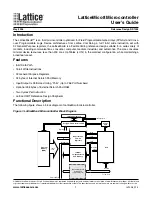Chapter 16 Freescale’s Scalable Controller Area Network (S12MSCANV3)
MC9S12XE-Family Reference Manual , Rev. 1.19
642
Freescale Semiconductor
The MSCAN then schedules the message for transmission and signals the successful transmission of the
buffer by setting the associated TXE flag. A transmit interrupt (see
Section 16.4.7.2, “Transmit Interrupt
”)
is generated
1
when TXEx is set and can be used to drive the application software to re-load the buffer.
If more than one buffer is scheduled for transmission when the CAN bus becomes available for arbitration,
the MSCAN uses the local priority setting of the three buffers to determine the prioritization. For this
purpose, every transmit buffer has an 8-bit local priority field (PRIO). The application software programs
this field when the message is set up. The local priority reflects the priority of this particular message
relative to the set of messages being transmitted from this node. The lowest binary value of the PRIO field
is defined to be the highest priority. The internal scheduling process takes place whenever the MSCAN
arbitrates for the CAN bus. This is also the case after the occurrence of a transmission error.
When a high priority message is scheduled by the application software, it may become necessary to abort
a lower priority message in one of the three transmit buffers. Because messages that are already in
transmission cannot be aborted, the user must request the abort by setting the corresponding abort request
bit (ABTRQ) (see
Section 16.3.2.9, “MSCAN Transmitter Message Abort Request Register
”.) The MSCAN then grants the request, if possible, by:
1. Setting the corresponding abort acknowledge flag (ABTAK) in the CANTAAK register.
2. Setting the associated TXE flag to release the buffer.
3. Generating a transmit interrupt. The transmit interrupt handler software can determine from the
setting of the ABTAK flag whether the message was aborted (ABTAK = 1) or sent (ABTAK = 0).
16.4.2.3
Receive Structures
The received messages are stored in a five stage input FIFO. The five message buffers are alternately
mapped into a single memory area (see
). The background receive buffer (RxBG) is
exclusively associated with the MSCAN, but the foreground receive buffer (RxFG) is addressable by the
CPU (see
). This scheme simplifies the handler software because only one address area is
applicable for the receive process.
All receive buffers have a size of 15 bytes to store the CAN control bits, the identifier (standard or
extended), the data contents, and a time stamp, if enabled (see
Section 16.3.3, “Programmer’s Model of
The receiver full flag (RXF) (see
Section 16.3.2.5, “MSCAN Receiver Flag Register (CANRFLG)
”)
signals the status of the foreground receive buffer. When the buffer contains a correctly received message
with a matching identifier, this flag is set.
On reception, each message is checked to see whether it passes the filter (see
”) and simultaneously is written into the active RxBG. After successful reception of a
valid message, the MSCAN shifts the content of RxBG into the receiver FIFO
2
, sets the RXF flag, and
generates a receive interrupt (see
Section 16.4.7.3, “Receive Interrupt
3
. The user’s receive
handler must read the received message from the RxFG and then reset the RXF flag to acknowledge the
interrupt and to release the foreground buffer. A new message, which can follow immediately after the IFS
field of the CAN frame, is received into the next available RxBG. If the MSCAN receives an invalid
1. The transmit interrupt occurs only if not masked. A polling scheme can be applied on TXEx also.
2. Only if the RXF flag is not set.
3. The receive interrupt occurs only if not masked. A polling scheme can be applied on RXF also.
Because
of
an
order
from
the
United
States
International
Trade
Commission,
BGA-packaged
product
lines
and
part
numbers
indicated
here
currently
are
not
available
from
Freescale
for
import
or
sale
in
the
United
States
prior
to
September
2010:
S12XE
products
in
208
MAPBGA
packages


















